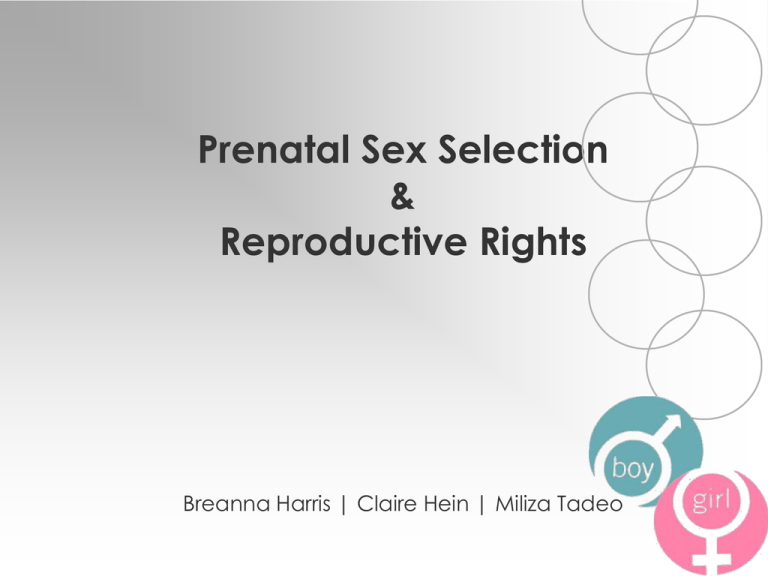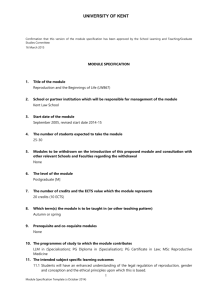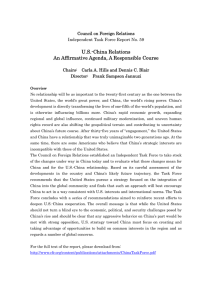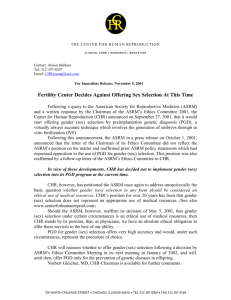
Prenatal Sex Selection
&
Reproductive Rights
Breanna Harris | Claire Hein | Miliza Tadeo
Sex Selection Defined
-- The attempt to select or
influence the sex of an unborn
child through medical and/or
non-medical means
“The basic rights of all couples and individuals to decide
freely and have responsibility of the number, spacing
and timing of their children and to have the information
and methods to do so.” - International Conference on
Population and Development
In what follows
•Categories of Sex Selection
•Portrayal in the US
•Legal & Ethical considerations
•World views
•Final thoughts
Categories of Sex Selection
•Flow Cytometry (sperm sorting)
- Most common
- Safety & effectiveness is the only regulator in the U.S. and
Great Britain
- U.S. success rate:
90% Girls & 73% Boys
•Preimplantation Diagnostics Test (testing of embryos during
in vitro fertilization)
- Frowned upon for the sole purpose of selecting child’s sex
- Supported for gender balancing among families
-Nearly 100% effective in predetermining the sex of a child
•Non-medical
-Modify body chemistry of parents
-Intercourse timing
-Dietary guidelines
-Nutriceuticals
-Vaginal environment adjustment
Sex Selection in the US
•Vanity
-Preferred hair or eye color
-Athletic ability, intelligence, physical prowess
•Becoming a “normal” form of conception
-New medicinal technology
-Public media
-Support groups
-At-home Kits
First Born Preferences
Source: Social sex selection and the
balance of the sexes: Empirical evidence
from Germany, the UK, and the US. Journal
of Assisted Reproduction & Genetics (2006)
Interest in Sex Selection
Source: Social sex selection and the
balance of the sexes: Empirical evidence
from Germany, the UK, and the US. Journal
of Assisted Reproduction & Genetics (2006)
Legal & Ethical Issues
Legal
“…if parents would consider the sex of their child
determinative of their decision to reproduce, then the
decision to select sex must be constitutionally protected”
vs
“Legal restrictions on use of noncoital reproductive
techniques might preclude persons from the only
reproduction possible for them [and] their procreative
liberty would be limited significantly."
Legal & Ethical Issues
Ethical
Is any form of gender selection ethical?
•Reinforcement of gender bias
•Imbalanced sex ratio
•Implications for eugenics
•Discarding of embryos
Final word from the ASRM Ethics Committee
“…Couples should be discouraged from undergoing IVF
with preimplantation genetic diagnosis solely to choose
the gender of offspring.”
“All methods of gender selection, even prefertilization
methods, are inherently discriminatory or sexist.”
“Preconception methods of sex selection could be
ethically used for creating gender variety in a family”
World Views
•Male sex preferred:
-South Asia, East Asia, North Africa, France,
-Neglect of health and nutrition of female fetuses
•Female sex preferred:
-Czech Republic, Lithuania, Portugal
•Forbidden in most European countries
•Ban on sex selection in Australia, not allowed in New
Zealand
-Only permitted to prevent “inheritable diseases”
•Infanticide among the impoverished
•Sex selection is not to be used for terminating a fetus
World Views
Asian Countries
•Sex Ratio
-China - 116.9 boys for every 100 girls (Wiseman, 2002)
-South Korea - 115 boys for every 100 girls (Wiseman, 2002)
•Media
-Male babies preferred for religious reasons
-China’s One-Child Policy creating “Little Emperors”
-Women only want high status mates
World Views
India
•Sex Ratio
1000 boys for every 793 girls
•Media
-Male babies cost less over a lifetime
“Invest 500 Rupees now, save 500,000
Rupees later.”
-Abortion is illegal
•Pre-Natal Diagnostic Techniques Act (1994)
-Prohibits technology use for the purpose of sex
selection
-Preventing abortion of female fetuses
Last Thoughts
•Are parents that choose sex selection “bad” parents?
•Does sex selection need to be regulated?
•Do we reject children without superior intelligence? Do
not have the right hair or eye color?
•Is pre-selecting your child’s sex being selfish?
Reference
Dahl, E. E., Beutel, M. M., Brosig, B. B., Grüssner, S. S., Stöbel-Richter, Y. Y.,
Tinneberg, H. R., & Brähler, E. (2006). Social sex selection and the
balance of the sexes: Empirical evidence from Germany, the UK, and
the US. Journal of Assisted Reproduction & Genetics, 23(7/8), 311-318.
doi:10.1007/s10815-006-9064-y
Hollingsworth, L. (2005). Ethical Considerations in Prenatal Sex Selection. Health &
Social Work, 30(2), 126-134. Retrieved from Proquest.
Library of Congress: http://www.loc.gov/law/help/sex-selection/india.php last
updated 2011
Remaley, R. E. (2000). 'THE ORIGINAL SEXIST SIN': REGULATING PRECONCEPTION
SEX SELECTION TECHNOLOGY. Health Matrix: Journal of Law-Medicine,
10(2), 249. Retrieved from EBSCOhost.
Robertson, J. (2002) Sex selection: Final word from the ASRM ethics Committee on
the use of PGD. The Hastings Center Report, 32(2), 6. Retrived from
Proquest












